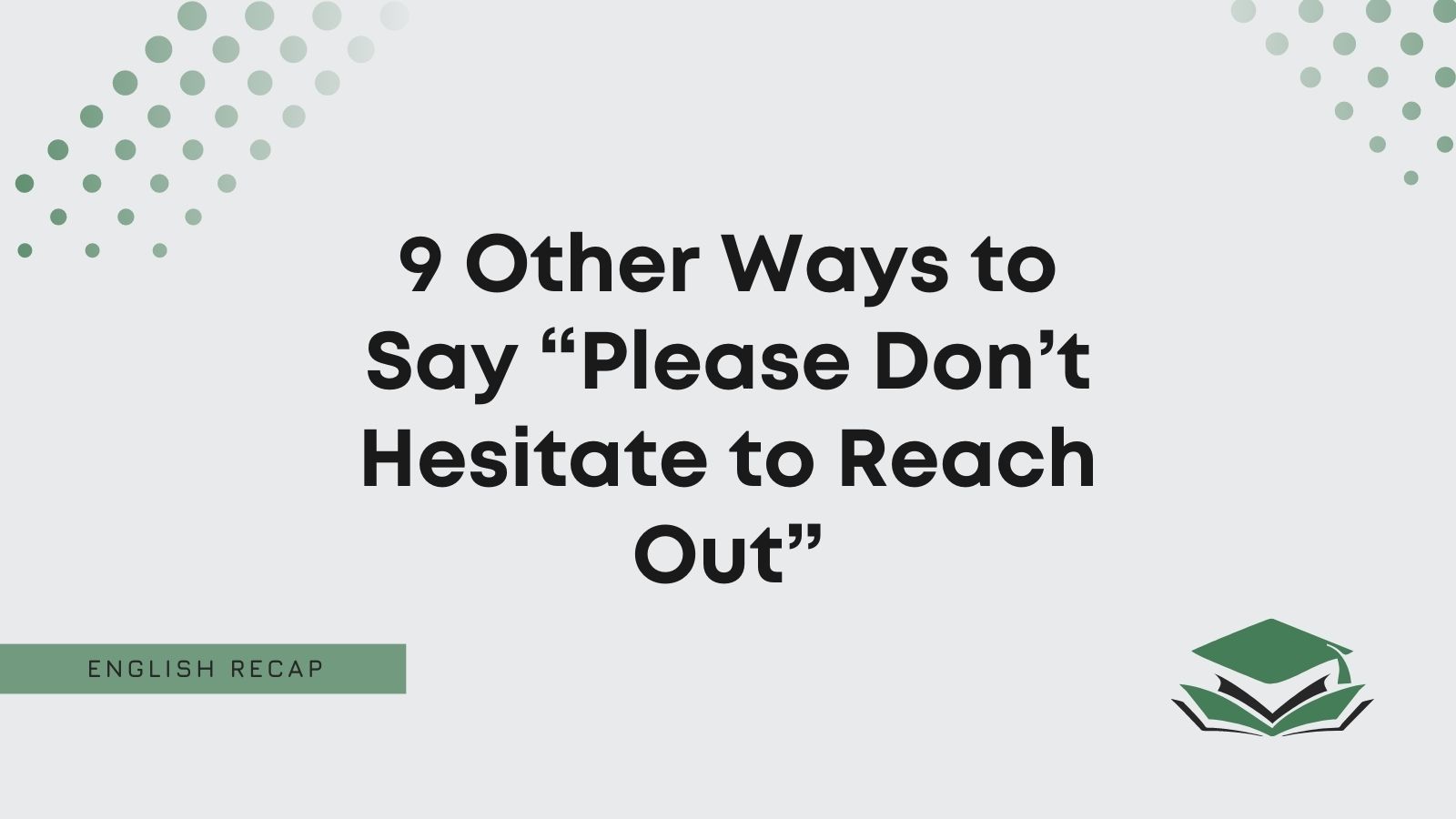Are you trying to encourage someone to email you if they need you? Perhaps you’re wondering if “please don’t hesitate to reach out” is the best phrase to use formally.
Luckily, this article is here to help. We’ve gathered the best alternatives to show you how to say “please don’t hesitate to reach out” professionally.
Is It Professional to Say “Please Don’t Hesitate to Reach Out”?
It is professional to say “please don’t hesitate to reach out.” It’s an excellent way to let someone know that you’d like to hear from them later.
We highly recommend using it in formal emails. It shows that you’re keen to hear from someone and would like to know if they have any thoughts to share.
Here’s an example to show you how it works:
Please don’t hesitate to reach out with any questions you might have.
Pros
- It’s polite and lets the recipient know you’re happy for them to message you.
- It’s very professional.
Cons
- It’s overused.
- It doesn’t explain what someone can reach out for (without further clarification).
“Please don’t hesitate to reach out” is certainly one of the best professional phrases to use. But that doesn’t mean you can’t have a few synonyms ready to spice things up.
Keep reading to learn another way to say “please don’t hesitate to reach out.” You can also review the examples under each heading.
What to Say Instead of “Please Don’t Hesitate to Reach Out”
- Please don’t hesitate to contact me
- Please let me know if I can be of further assistance
- Feel free to reach out
- Feel free to contact me
- Don’t hesitate to ask
- Please get in touch
- Feel free to email me again
- Please let me know if you have any questions
- Contact me again if you think of anything else
1. Please Don’t Hesitate to Contact Me
One of the simplest alternatives to “please don’t hesitate to reach out” is “please don’t hesitate to contact me.”
It allows you to sound more formal by using a professional phrase like “contact me” rather than “reach out.”
We recommend using it when emailing clients. It shows you’re happy to discuss matters further with them if they have any questions.
The idea is that you’re reaching out a hand to assist someone if they need you. It’s then up to the recipient to decide if they want to contact you again to ask for more help.
You can also review the following email example:
Dear Mathew,
I’m happy we could work this out so quickly. Please don’t hesitate to contact me with any questions.
All the best,
Martha Redness
2. Please Let Me Know if I Can Be of Further Assistance
Another professional alternative showing you how to end an email is “please let me know if I can be of further assistance.”
We recommend using it right before you sign off an email to show you are helpful and polite.
For instance, you may use it when working with customers. It shows that you have answered their initial query without issue, but they may still have questions.
So, you can use this phrase to indicate that you’re happy to take any questions. It encourages them to reach out if they need you.
Here’s a great email sample to help you:
Dear Mr. Keating,
I hope I have helped you understand what to do next. Please let me know if I can be of further assistance.
All the best,
Carl Pilkington
3. Feel Free to Reach Out
We recommend using “feel free to reach out” as a more conversational alternative. Don’t get us wrong; it still works in your emails. However, it’s best when you don’t rely on overly formal language.
For instance, you should use it when emailing colleagues. It shows you’re happy to answer any questions they might have.
After all, you never know when your colleagues are going to come to you for help. It’s best to make yourself a reliable source to let them know they can count on you.
Perhaps this example will also clear things up:
Dear Sara,
Feel free to reach out if you have any questions. I want you to know that you can count on me here.
Yours,
David Crocker
4. Feel Free to Contact Me
Another great conversational alternative is “feel free to contact me.” It’s useful because it shows that you’re offering your services to someone if they choose to take them.
You can say “feel free” to encourage someone to reach out. It’s a very positive and polite phrase, showing that the recipient shouldn’t be ashamed to ask you for help.
After that, “contact me” is a professional option to ask them to email you. Feel free to use it to let them know you’re happy to help.
If you’re still unsure, review this sample email:
Dear Daniel,
Feel free to contact me for further assistance. I’m only an email away, and I’d like to be of service.
All the best,
Erik Mummel
5. Don’t Hesitate to Ask
“Don’t hesitate to ask” works really well here as well. It’s useful when emailing customers who might have reached out with a query.
You can also say “don’t hesitate to ask” if you have contacted a customer first. It shows that you’re always happy to take questions. Usually, this applies best when it’s your job to help customers understand more about your company.
Check out this email example as well:
Dear Russell,
Don’t hesitate to ask if you need anything. It’s my duty to help you understand what to do here.
Yours,
Greta Kingston
6. Please Get in Touch
You should always try to encourage customers to ask questions if they need to. After all, in professional circumstances, if you’re an employee, you’re usually the person that customers rely on for help.
Something like “please get in touch” works well here. We highly recommend using it to maintain a polite and respectful tone.
It shows you’re happy to help someone as long as they reach out first. It’s up to them to decide what questions to ask if they do this.
This sample email should also help you understand it:
Dear Abe,
I hope this has helped you understand what to do. Please get in touch with any questions you might have.
Thank you so much,
Dean Gravesend
7. Feel Free to Email Me Again
Another great alternative to “please don’t hesitate to reach out” is “feel free to email me again.” It suggests that someone should email you more if they need help.
Using “again” shows that you’re happy to hear from someone. We recommend it when emailing clients after helping them understand something.
It’s very professional and helpful, making it an excellent choice in nearly every business situation.
Perhaps the following email example will help you:
Dear Mr. Jacobs,
Feel free to email me again if you need any help. I’m here to make things as simple as possible for you.
All the best,
Mario Lopez
8. Please Let Me Know if You Have Any Questions
You may also write “please let me know if you have any questions” rather than “please don’t hesitate to reach out.” It shows you are open to answering any questions someone might have.
Using “if you have any questions” in this phrase shows that you’re willing to help however you can. It also gives the recipient an idea of what they can reply with to ask you for more help.
Try it the next time you email a customer about their query. It shows you have answered their initial question and would like to help them if they come up with any more.
This example will also shed some light on how it works:
Dear Ana,
This is all I can say about it. But I’m still here if you need me. Please let me know if you have any questions.
Best regards,
Duncan Firth
9. Contact Me Again if You Think of Anything Else
Let’s assume an applicant has already asked you questions about a job role. You may have answered them to the best of your ability, but they might still think of something else to ask you.
It’s always good to leave an email open-ended. A phrase like “contact me again if you think of anything else” is a great way to do this.
After all, it shows you’re happy to answer more questions. It’s up to the recipient to decide if they want to ask anything else before ending the email conversation.
If you’re still unsure, this sample email is for you:
Dear Samantha,
I hope I’ve answered all your questions thus far. Contact me again if you think of anything else.
Yours,
Darren Waterman

